Astrological aspects and sacred geometry
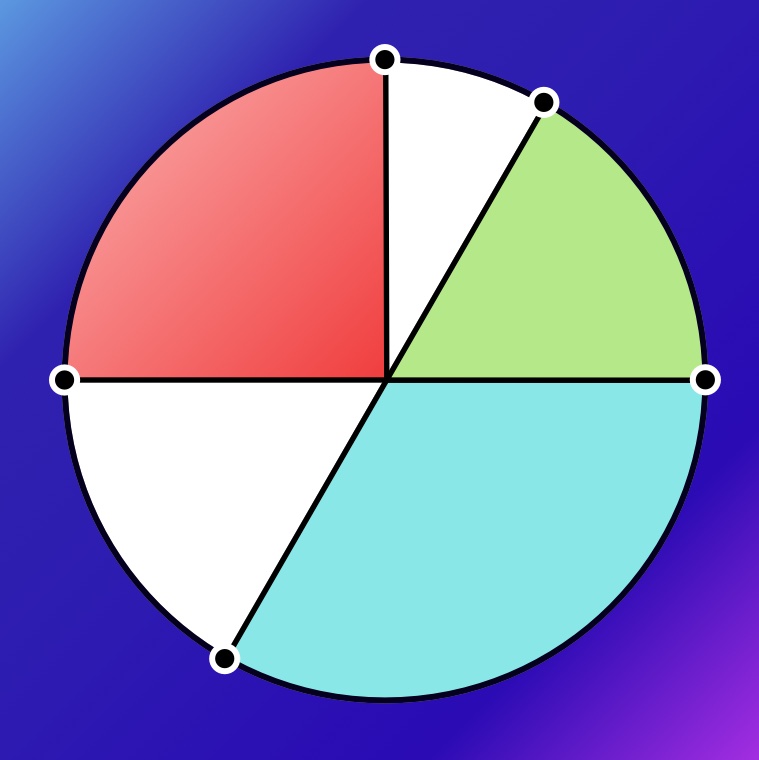
Aspects that the bodies of an astrological chart form between themselves provide a rich underlying framework for natal chart interpretations. The power of aspects comes directly from the domain of sacred geometry, a universal set of principles that connects us with structure of the Universe.
Each astrological chart is a kind of still photograph or a snapshot of planetary dispositions at some point in time, typically the moment of your birth. Yet there is more to that. The chart defines the “chemistry” between its planetary energies. By “chemistry” we mean something that is dynamic, malleable and yet still can be described via its basic ingredients.
A deeper understanding of astrological aspects that constitute the chart’s narrative helps uncover insights into the dynamic processes that make each natal chart “dance” and be a living guidance rather than a fixed formula.
We shell begin with a typical confusion that arises when one puts too much weight on the Zodiac signs.
A typical source of confusion: “I am somewhat different from my sign”
In our example we’ll be using someone born under the Libra sign but you’re welcome to replace Libra with any other sign, it’ll still work the same.
Typical confusion with the Zodiac signs is in the common attitude to use them with a cookie cutter approach.
Instead of saying, for example, “my Sun is in Libra and therefore I am such and such”, you can allow yourself to have a more complex and multi-dimensional psychological profile. There isn’t much value in a fixed identification — perhaps many of us witnessed certain puzzling exceptions to our “prescribed” astrological profiles.
Still using the example of somebody who was born under the Libra sign, there can be instances when their behaviour will be more akin to a Scorpio person, and at other times they will display certain Cancerian traits.
It should be pretty obvious that there are more than twelve types of psychological profiles in this world.
Every “Libra” is somewhat different
While each Libra person may act according to their Libra psychological profile in 90% of life situations, there will be some significant exceptions to the rule. And under certain intense conditions the person will not be like their sign at all.
The idea of assigning each of us a certain astrologically branded psychological profile was a convenient oversimplification that does help at the entry level but fails to deliver in more complex real-life situations.
In order to produce a precise psychological profile and really “understand the person”, one should expand their perception to the domain of planetary interactions, the chemistry between the main ingredients of the Solar System — the planets.
Planetary energies to the rescue
Taking a musical analogy, each Zodiac sign is akin to an octave. Any non-trivial and compelling musical piece requires use of multiple octaves, so does each person.
Complexity of human personality can be expressed via the language of planetary energies and their interactive nature. It is also worth noting that the planets rule over the Zodiac signs, not the other way around. This idea gives us an important observation that in order to understand the Zodiac signs, one must first understand the energies of the classical planets (Mercury, Venus, Mars, Jupiter, Saturn) and the two luminaries (the Sun and the Moon).
The Zodiac signs are more akin to broad strokes painting while the planets provide exacting details.
The dynamic nature of planetary energies creates a fluid cocktail of forces, its “recipe” is encoded in the natal (or birth) chart. Yet recipe is only an instruction, it’s up to each chef to implement baking of cakes.
It is well established that baking is a truly alchemical activity — and so is the unfoldment of an astrological chart.
Visual alchemy of astrological charts and sacred geometry
If the planets are the “ingredients” of the chart then the aspects are the principles that bond or repel planetary energies. Aspects provide the matrix of principles that modify, enhance or mute planets and thus their expression in human psyche.
When looking at multiple astrological charts, what immediately stands out is the geometrical nature of the aspects. Each chart presents us with its own “story” expressed via connecting lines and colours.
To illustrate the point, below are four charts of four prominent people: two spiritual teachers, Sri Aurobindo and Rudolf Steiner, and two scientists, Albert Einstein and Nikola Tesla. Can you notice some patterns? A tip: Opening the page on a larger screen will help.
It can be observed that geometry of charts of spiritual teachers passes an impression of expansive and flowing nature. Geometry of the charts of scientists and inventors is sharp and focused. That’s a very quick observation, there is certainly more to discover.
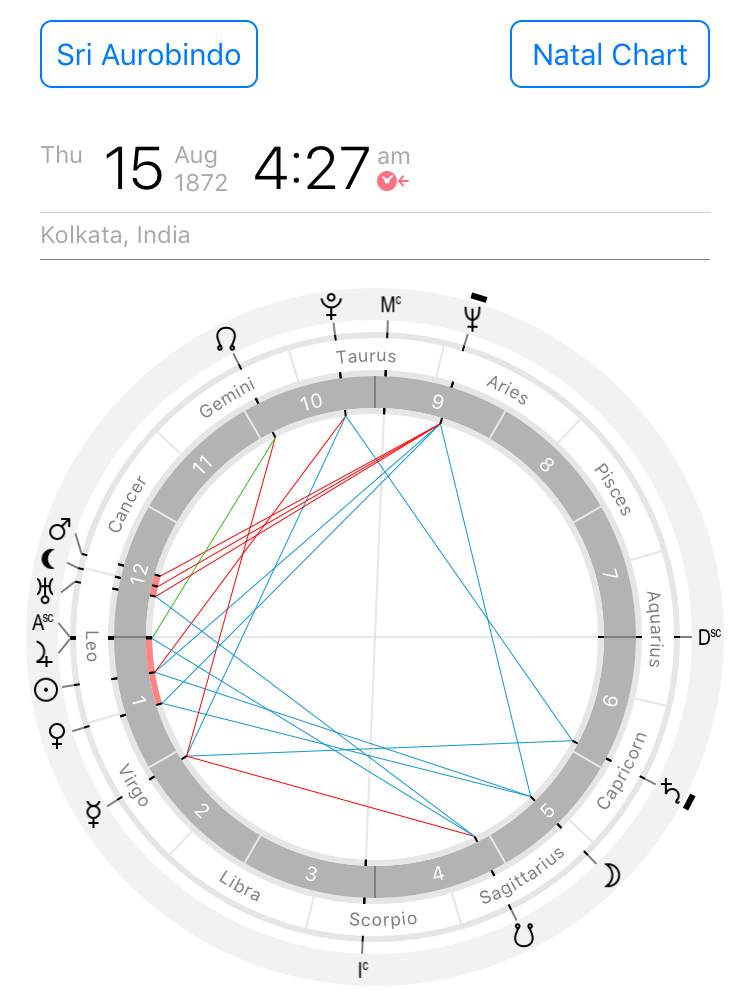
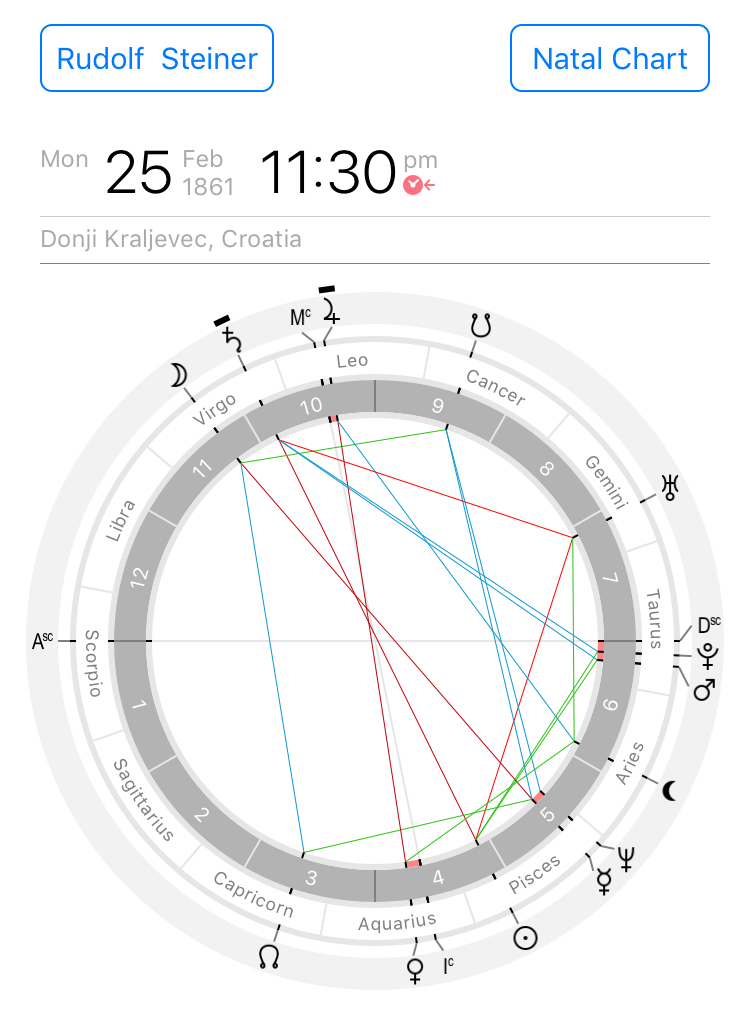
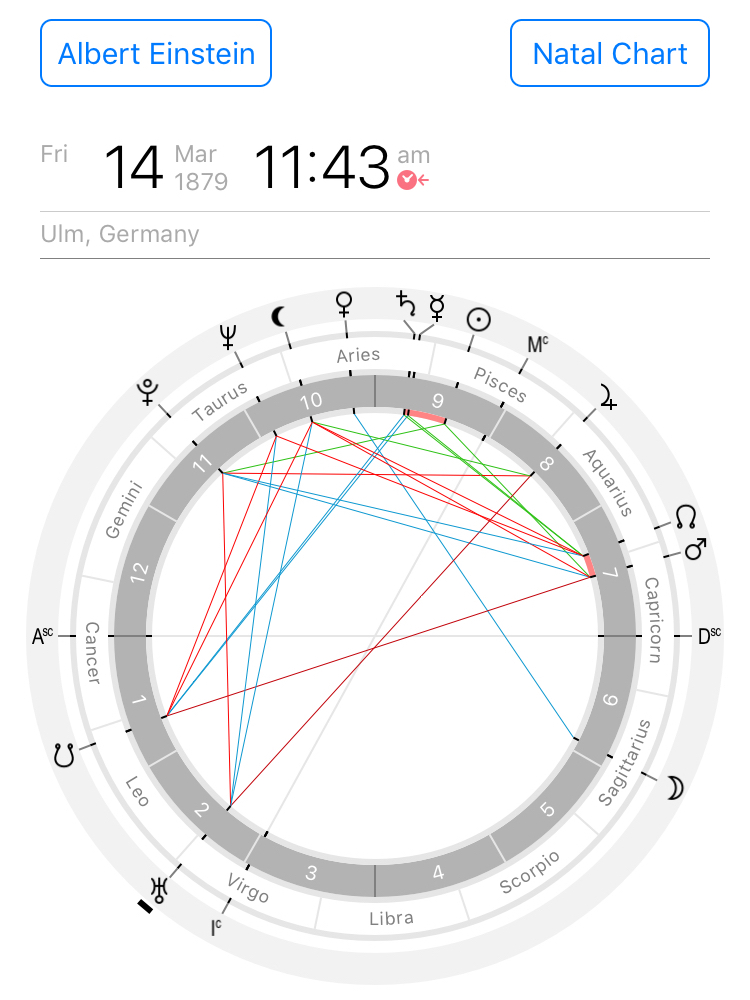
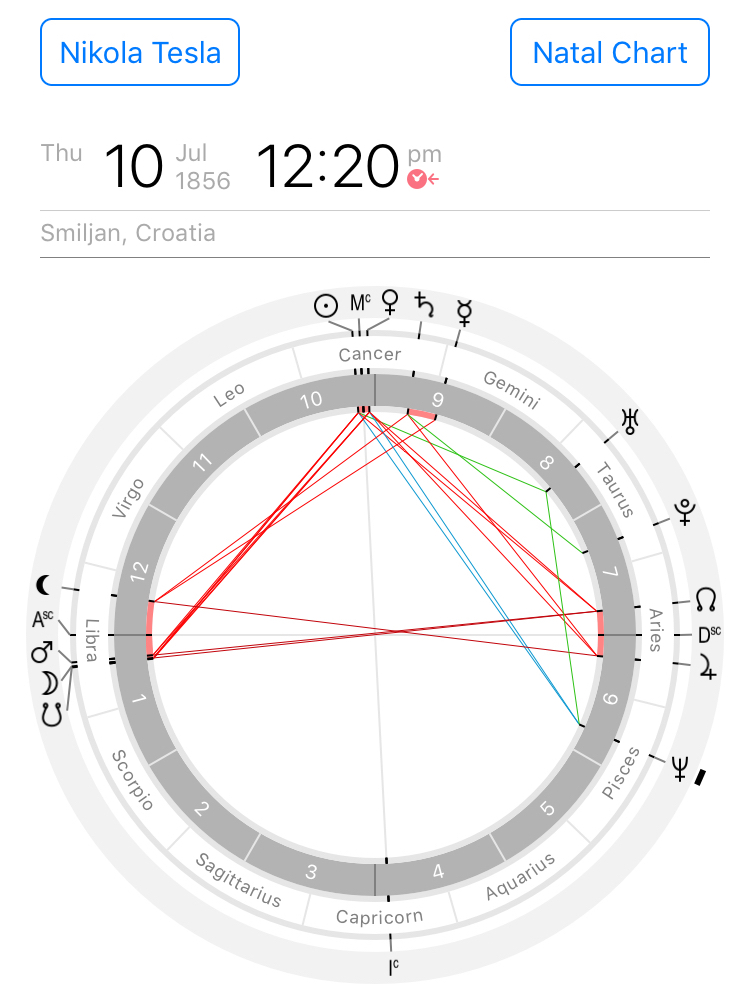
The visual nature of charts is the expression of sacred geometry that underpins many important areas of metaphysical knowledge.
Skipping its textbook definitions, sacred geometry can be described as the study of simplicity that creates immense complexity while still retaining its original sense of beauty and connection to the source.
Sacred geometry have been used in all religious contexts as both ornamental and symbolic language. In its essence, the magnetic force of sacred geometry lies in its elegant and mesmerising nature. One can start with a simple line and only using basic drawing tools produce some immensely complex yet profound shapes.
Sacred geometry is connected to the source. And the source can be nothing more than a dot. That’s how the universe began.
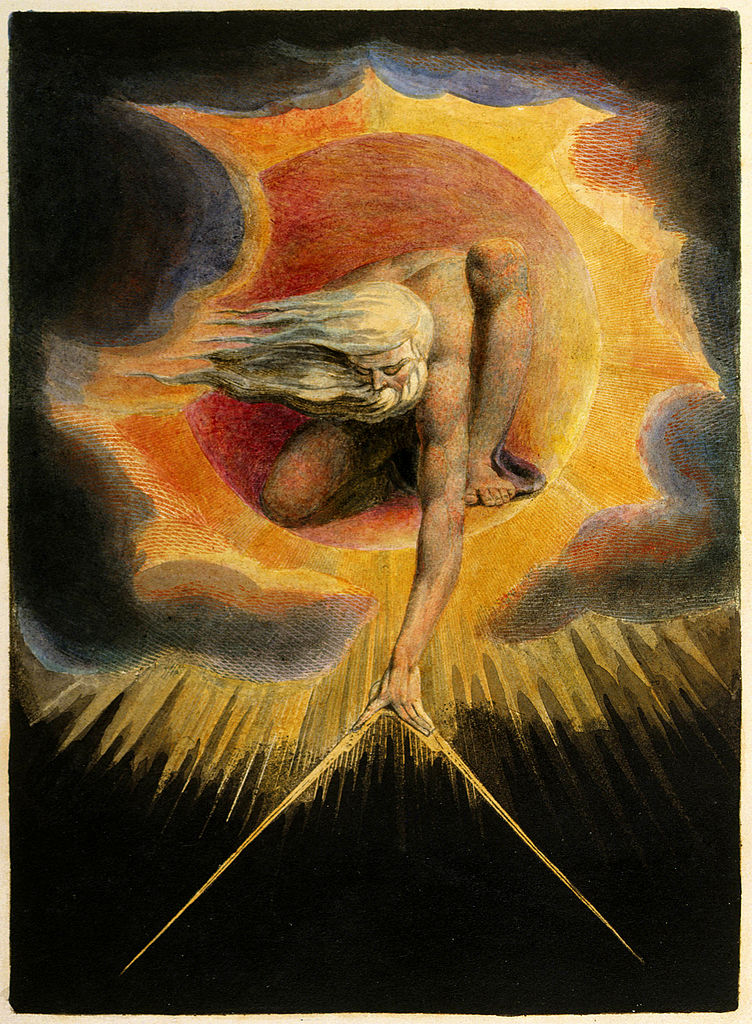
Especially interesting to see the Creative Spirit residing in a circle and using a 90º angle to manifest the material world underneath. That brings some obvious parallels to the circular nature of an astrological chart and the square aspect.
The circle of an astrological chart stands for the unity of the Spirit while the aspects act as manifesting forces.
Aspects and their meaning
While astrological aspects are geometric in nature they also offer some deep metaphysical meaning. We are going to explore both dimensions of each aspect, starting from geometry and proceeding to the meaning and interpretation.
The most important aspects are called “major aspects”:
- Conjunction, 0°
- Opposition, 180°
- Trine, 120°
- Square, 90°
- Sextile, 60°
The lesser aspects called the “minor aspects” that can be further divided into the proper minor aspects and rare minor aspects:
- Inconjunction, 150°
- Sesquisquare, 135°
- Quintile, 72°
The “rare minor aspects” is a subcategory of minor aspects, their meaning is rather obscure and is a subject of ongoing debate and investigation:
- Tridecile (tredecile, tri-decile), 108°, three deciles (see “decile” below)
- Septile, 51.4°, a seventh of a circle
- Semisquare, 45°, half a square
- Novile, 40°, a ninth of a circle
- Decile, 36°, a tenth of a circle
- Undecile, 32.7°, the eleventh part of a circle
- Semisextile, 30°, half a sextile
- Quindecile, 24°, a fifteenth of a circle
- Vigintile, 18°, a twentieth of a circle
The list of aspects can be extended as much as one pleases. The principle behind every aspect is a division of a circle according to some method and there can be infinitely many ways to divide a circle.
Conjunction, 0º
Conjunction is a simple dot, a blob of ink on paper with infinitely small size. Another way to depict conjunction is a circle. Circle has no beginning and no end, it’s infinitely one and yet infinitely smooth and dynamic.
Numerically conjunction corresponds to the number one. The exact conjunction has angular distance of zero degrees between two planets. Conjunction relates to the 1st house.
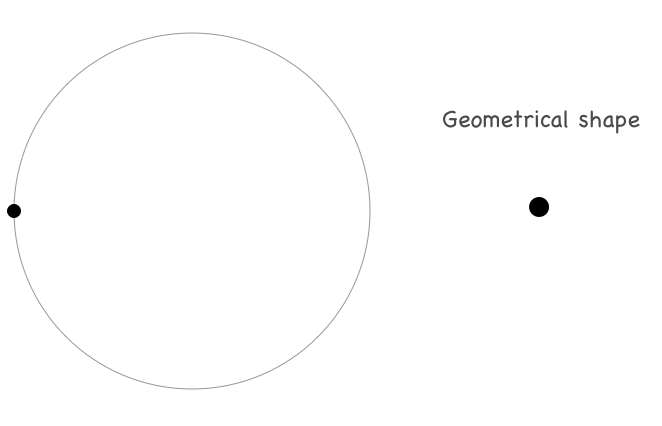
Before there was day and night, left and right, up and down, right and wrong, everything existed in an undifferentiated state of unity.
Conjunction symbolises the combination of forces when two planetary energies are mixed into one unified force. Conjunction is the most powerful of all aspects due to its direct nature.
Opposition, 180º
Opposition is formed by two diametrically opposed points on the circle.
Numerically opposition corresponds to number two. Exact opposition has angular difference of 180º. Opposition relates to the 7th house.
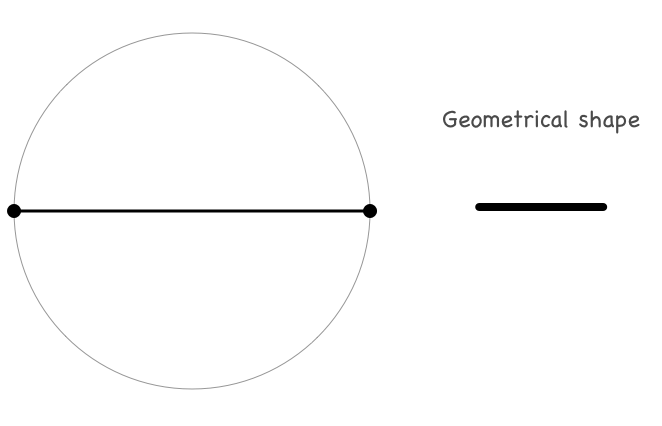
Opposition symbolises the moment of maximum separation when two opposing principles have been crystallised out of original unity. Opposition is the symbol of maximum manifestation. Light and darkness, truth and falsity, left and right.
The Full Moon is the moment of opposition that we experience first hand on a regular basis. Planets in opposition are characterised by the fullness of their energetic manifestation. The fullness calls for proper handling and integration: a good approach is to avoid suppressing one planet in favour of another. A well-rounded personality can be characterised by carefully balanced oppositions of forces that ensures smoothness of operation while minimising stress levels.
Trine, 120º
Trine is formed by dividing the circle into three equal parts.
Numerically the trine corresponds to number three. Exact trine aspect has angular distance of 120º. Trines relate to the 5th and 9th house.
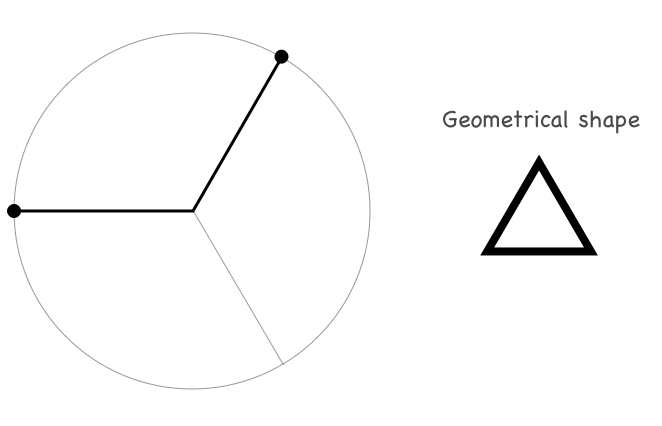
Manifestation has followed its course and the two polarities produced the third principle. Just like when man and woman unite to create a child. Trines are the forces of flow.
Any two planets that form a trine can be seen as a flowing relationship, a mini family that produces offsprings in the form of deeds and events. Just like with any human family, it’s not always smooth but it’s certainly dynamic. It is wise to rest on that inherent quality of flow and be creative about the planets that form the trine.
Square, 90º
Square is formed by dividing the circle into four equal parts. Consecutive points are 90º apart. Numerological symbol of square is the number four. Four is the symbol for matter and the material world, the Earth as well as all other bodies of the physical universe.
Squares relate to the 4th and 10th houses. Square is traditionally coloured red for a good reason. It’s a symbol of confrontation.
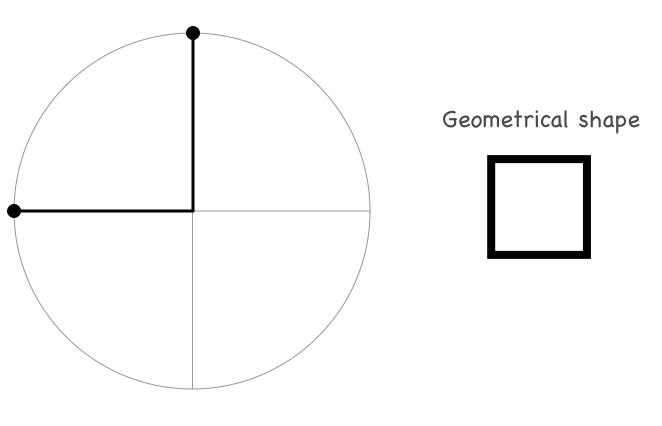
Confrontation of the square isn’t bad at all, on the opposite, it’s an invitation to make things happen. Great examples of the square aspect is the First and Last Quarters of the Moon. By no means they feel sinister or hard, yet they carry the energy of the square that pushes us to create and manifest while progressing towards the next lunar phase. Squares are practical in essence. Keep that in mind that analysing your birth chart, they help to make the most out of two planetary energies.
Yes, there is a negative side to square aspect. It’s way too fixed — just like a cube or a kitchen table — the square resists transformation and changes. Squares introduce stickiness and repeating patterns that bring frustration. To counteract this, introduce dynamism of the trine, keep moving, any kind of physical work is a great way to destress and restart the flow.
Sextile, 60º
Sextile is formed by two points on the circle that are 60º apart or one sixth of the whole circle. Or if speaking in the Zodiac signs, they are two signs apart. Sextiles relate to the 3rd and 11th houses.
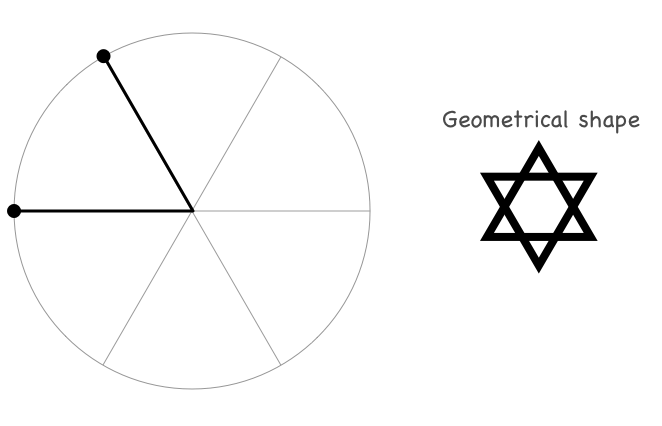
Sextiles can be seen as half-trines. They are “on their way” to start manifesting. Generally speaking, sextiles are of very minor importance, they provide a gentle guiding influence and one can comfortably use their supporting harmony.
A pro tip: Remember that Jupiter has affinity with number 6 thus giving any sextile that involves this planet some very special significance.
All major aspects at once
Putting all major aspects side by side a following image in emerging.
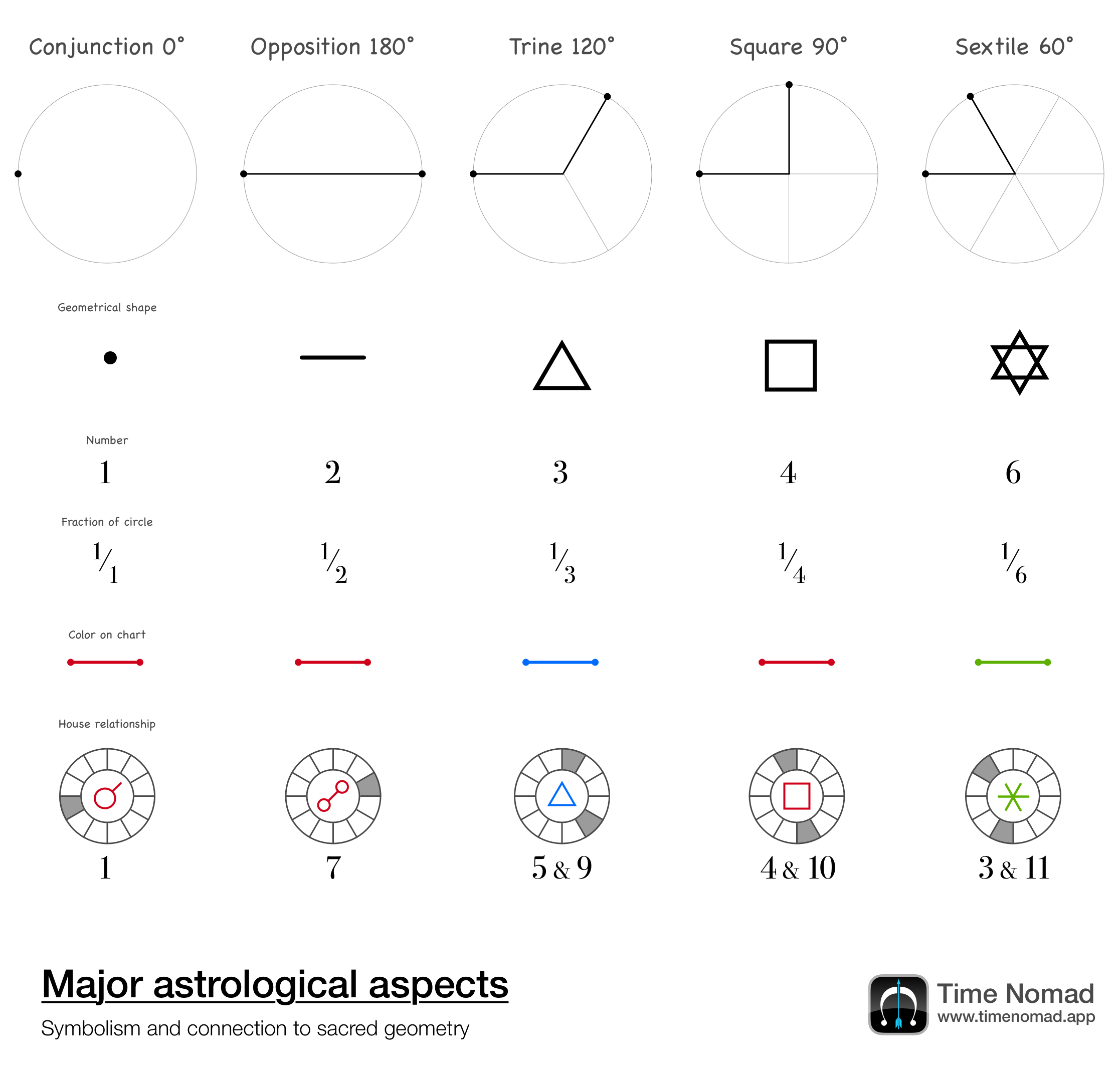
What immediately stands out is that there are only four aspects that are “major-major”, namely:
- Conjunction, 0°
- Opposition, 180°
- Trine, 120°
- Square, 90°
From the sacred geometry perspective these four aspects correspond to primary geometrical shapes: dot or circle, line, triangle and square.
The sextile aspect of 60° isn’t a primary “pure” shape, it’s a composite of two triangles and thus is somewhat of an outcast in the major category. Sextiles do have influence but they are nowhere close to the four foundational aspects.
To be continued with the minor aspects…
In the next part of the story we will look into the mysteries of minor aspects and their occult powers. Stay tuned.
12 Comments
Claudio Silvaggi
The Golden Ratio triangle is 36deg-108deg-36deg. This is the a triangle of 1-phi-1. The decile and tridecile is something that would be very beneficial as this would help in predicting weather. Would love it if you could make those aspects available. thanks for all the excellent work you do brother! p.s. I still have not gone through your email :-)
Time Nomad
Thanks for pointing it out Claudio! That’s a beautiful triangle, totally agree. Will visualise it properly in the next part of the story. Will get to adding those aspects to the app too, it just all takes so much time, but certainly moving along.
UN
Thanks for this great article. Just want to express gratitude for your work and your app - it goes appreciated!
Axelle
This was beautifully written! Mathematical poetry, I’m truly grateful for the energy you invested into this piece. You used the perfect mix of words to explain this and I really enjoyed reading it. Blessings to you
Shawntay Doraé
Thank you so much for sharing your wisdom! 🙏🏽 I’m trying to teach myself. Lol your such a big help!!
Jeff Streitmatter IV
Who writes all these articles? I am blown away by the quality of your UX in the app and the writing here on your blog. I would love to pick the writer’s brain.
Brittany
I to have been teaching myself more about astrological aspects and this blew me away. I am eternally grateful and thankful for your time, efforts and energy put into this article, speechless♥️
Robert
There is no such thing as a tridecile. It was given the name TREDECILE by the person who “discovered” it, Johannes Kepler himself.
Time Nomad
I know, there are at least three spellings one can find: tredecile, tridecile and tri-decile. Since the decile is 36º, the usage of the modern “tri” prefix meaning “three” for 3*36. I’ve updated the article to include alternative spellings.
Stephanie
Hi where can I find more info on the number 6 and the affinity with Jupiter?
Time Nomad
The key word here is “affinity”. For example, if one looks at the sequence of planetary spheres, the sphere of Jupiter is in the sixth sphere when counting from the sphere of the Moon upwards.
Also, Jupiter relates to number 12 which is roughly the number of years it takes the planet to complete the Zodiac (~1 year per sign). This doesn’t give a strict formula but there’s an intuitive sense that Jupiter is somehow related to the number 6 – more than any other planet. By working with astrological charts, one learns to get a feeling of the Jupiter’s influence when it comes to sextiles.
Bruno
s that a lot of math to know for sacred geometry or is this a continuation of our elementary geometry that we learned in grammar school and High school. I am very interested in geometry from a math point of view. Thank you.